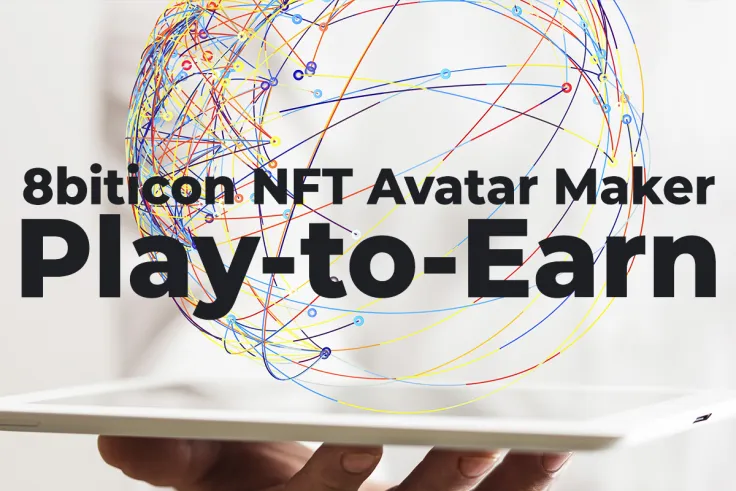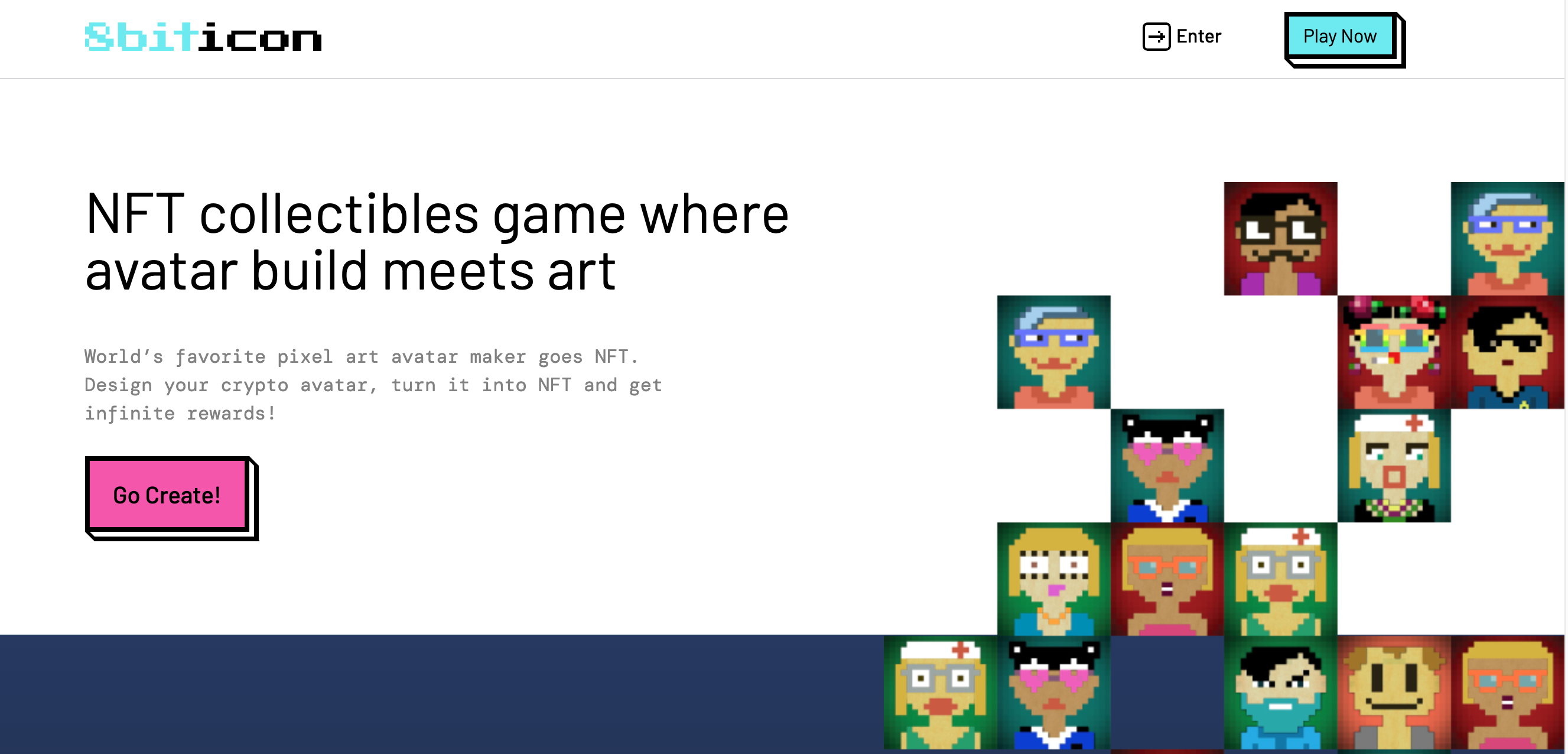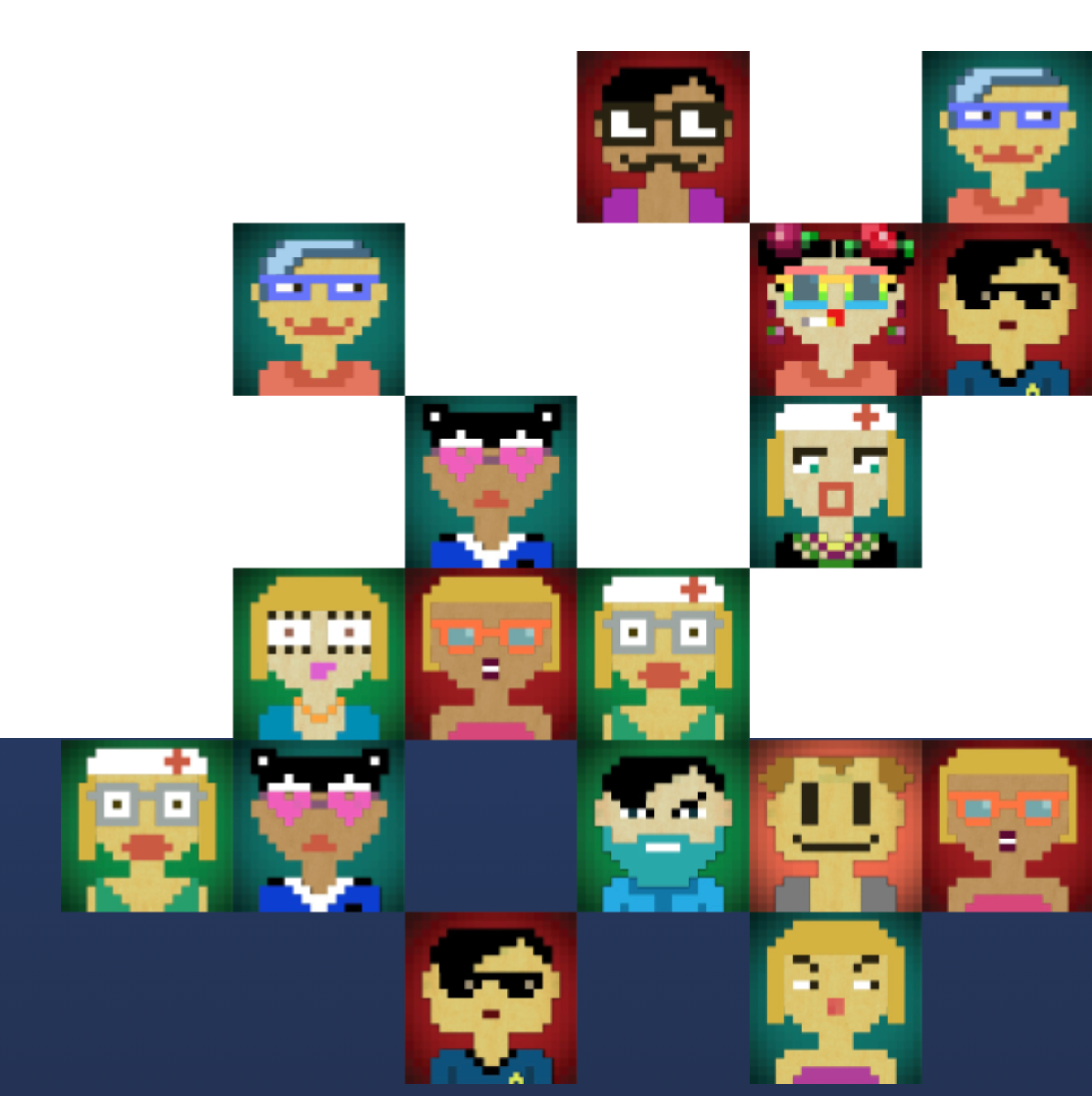
- Introducing 8biticon: What is special about this NFT pixel character creator?
- 8Biticon basics: What are NFTs and why do they go mainstream?
- Creating tokenized avatars with 8biticon.com
- 8biticon economics: Art markets, reconsidered
- Multi-source revenue model of 8biticon
- 8biticon 2.0: New generation of gamified DeFi
- Bottom line
8biticon is an NFT pixel avatar creator where players can tokenize their avatars and earn real Ethers in a unique community-driven initiative. Even crypto newbies can join the vibrant and impressive “movement”.
Introducing 8biticon: What is special about this NFT pixel character creator?
8biticon should be considered a one-of-a-kind gamified DeFi protocol where its users can benefit from interest in their pixel artwork. Briefly, users can create pixel avatars with various elements and be rewarded when someone else creates an avatar with the same elements.

But why should we treat 8biticon as a groundbreaking NFT-focused experience?
8biticon NFT Avatar Generator Invites Everyone to Tokenize Avatars and Earn
There are some points we should mention before starting a detailed review of 8biticon:
• Minting of NFTs has never been easier: 8biticon released an “out-of-the-box” instrument;
• No previous experience in blockchain and crypto is required;
• NFT monetization strategy on 8biticon is clear, transparent and rewarding;
• Technique of NFT production is easy: you do not need to be an artist or web designer
• 8biticon doesn’t charge its users with fees, only fees of the ETH network apply;
• No limits are set for NFT prices on 8biticon: monetization of digital collectibles may be more profitable than elsewhere.
8Biticon basics: What are NFTs and why do they go mainstream?
After smart contracts and DeFis, non-fungible tokens (NFTs, digital collectibles and so on) became “the next big thing” in the cryptocurrencies segment.
What are NFTs?
Non-fungible tokens, or NFTs, represent the specific type of tokens on one of the programmable blockchains (decentralized networks with smart contracts): Ethereum (ETH), Tron (TRX), Binance Smart Chain (BSC), Tezos (XTZ) and so on.
The characteristics of some physical objects (in particular, property rights) can be stored as NFTs. Typically, NFTs are designed to tokenize paintings, songs and videos while text and documents are rarely “tokenized.”
Therefore, NFTs can be bought and sold like physical property; normally owners trade them via decentralized auctions.
NFT euphoria: main reasons
The popularity of NFT markets grows at an increasing pace as they bring blasting changes to various segments in art and technology. First, with NFTs, everyone can sell their artwork in a manner that was previously accessible only to a small cohort of sophisticated professionals. Every artist can offer his/her paintings on an auction while every crypto enthusiast can develop himself/herself into an art dealer.
Also, some NFT auctions made headlines due to the jaw-dropping prices of core items for sale. Top-notch artists (e.g., Beeple) and traders (Metakovan) made dozens of millions overnight. Binance and Tron Foundation have launched their own marketplaces for NFT trading.
Creating tokenized avatars with 8biticon.com
As the main economic incentive for 8biticon players is to benefit from the popularity of their NFTs, first of all, these NFTs should be created. In order to customize a tokenized avatar, guests of the 8biticon website should enter the “Constructor” mode that is available using the “Play Now” and “Go Create” buttons on the main page.

Then, the user should choose between two options, “Essentials” and “Originals.” Both represent the collections of avatar presets the user can select. Male and female avatars are available with different skin colors, faces shapes, outfits, hair types, mouth forms, beards/moustaches, glasses and background colors.
Each element has its “basic” price: normally, it varies between 0.003 and 0.004 Ethers each. Thus, the entire avatar picture underpinned by an Ethereum-based NFT (“face+clothes+eyes+hair+mouth”) is worth 0.015-0.02 Ethers.

The purchase of newly minted NFTs is available with any type of valid Web3 wallet - an instrument for storing and selling Ethers and Ether-based tokens, as well as the tokens of EVM-compatible blockchains like Polygon and BSC. The simplest one for beginners is Metamask: 8biticon shares a detailed guide on how to utilize Metamask to purchase in-game NFTs.
Once the transaction is authorized by the client’s keypair, the non-fungible token is included in the Ethereum (ETH) blockchain; it cannot be removed, replicated, counterfeited, destroyed, lost or changed.
8biticon economics: Art markets, reconsidered
According to the detailed tokenomics manual provided by the 8biticon team, all transactions related to minting, buying or selling NFTs are executed on-chain via a smart contracts architecture to ensure the transparency and one-click verification of everything that is going on with users’ tokens.
A dynamic NFT price model is among the most interesting concepts of the 8biticon in-game economics design. The price of every in-game NFT includes two parts: a minting price and a demand-adjusting markup.
The minting price is more or less stable: it is designed to cover the expenses of the platform itself., i.e. development progress, website hosting, CDN services, smart contract maintenance and so on.
Demand Adjusted Markup (DAM) is an integral metric designed to reflect interest in this or that non-fungible token. It adjusts the price based on how many times other users have purchased its elements. The DAM is calculated by the specific formula that considers all price catalysts:

Where:
n = the number of elements in the avatar. At press time, five elements are available to users (face, clothes, eyes, hair, mouth)
B = minting price. Each layer costs 0.003-0.004 Ethers, which means that a complete picture costs 0.015-0.02 Ethers.
N = the number of times each element has been purchased. Should brown-haired female avatars become trendy, every creator of such a picture will be rewarded, making their DAMs skyrocket.
k = the uniqueness coefficient. It is a calculated ratio of the number of elements in the layer to the total number of elements. The ratios can be found on the 8biticon website since they may change as the smart contract structure is updated.
8biticon sticks to the “80 percent reward sharing” model. This means that an initial creator of an avatar receives 80 percent of the premium from every next creation of an avatar with the same element - such as glasses, mustaches, hair, etc. Once an avatar with that element is created again, 80 percent of the premium is split between the first and second holders of the “original” avatar.
However, the stream of rewards is directed to the actual owner of the property rights to this or that NFT. As a result, if a token is sold, the seller accrues its actual (realized) value but stops accumulating rewards from the creators of similar tokens.
Multi-source revenue model of 8biticon
The design of 8biticon revenue models includes three core elements. First, its “80 percent reward sharing” design as described above. The sooner a certain NFT is purchased, the greater the revenue collected from later generations of copycats, and their copycats and so on.
Then, not unlike other NFTs, tokens minted via 8biticon can be resold through third-party marketplaces. The largest NFT trading platforms are built on Ethereum (ETH), so the tokens can be transferred seamlessly with no extra fees for minting.
Another source of income for players of 8biticon comes from a lucrative referral program. Once a user purchases his/her first avatar, he/she receives a unique referral link. Information on this link is included in smart contracts. Thus, the entire process is fair and transparent.
Obtaining this link allows holders to benefit from his/her social exposure. The owner of the referral link will receive a commission on all purchases made by the people who clicked on it.
While a typical referral program in crypto garners a 10 percent commission for the participant, artists on 8biticon receive 15 percent of the base token price and five percent of its Demand Adjusted Markup (DAM).
8biticon 2.0: New generation of gamified DeFi
To reflect the progress of the NFT segment and the platform itself, 8biticon engineers introduced the 8biticon 2.0 upgrade that introduces new collections of customized avatars.
While “Essentials” will remain as they are for early adopters of 8biticon solutions, “Originals” come in a new format of 32x32 as the “8 bit icon” goes far beyond pixel art. This collection boasts better proportions and more details applicable to every avatar created.
Finally, “Specials” collections will be implemented as a dedication to specific themes. For instance, 8biticon will offer Samurai-themed, Zombie-themed and many other collections of particular interest for the fans of various subcultures.
Bottom line
Launched in 2012 by Matvey Dyadkov, founder of the iconic crypto ad network Bitmedia, 8biticon was an experiment for many years. However, with an NFT boom, it now allows creative people to monetize their tokenized avatars without any special expertise.
The project is fully on-chain by default, so it is an unmatched opportunity for newbies to familiarize themselves with the world of NFTs. As a one-of-a-kind gamified DeFi, it empowers its clients with three independent sources of revenue.
With 8 biticon, the lines between DeFi, NFTs and gaming are blurred. Therefore, it might be a smart bet to experiment with this combination of entertainment, trading and passive income.
 Dan Burgin
Dan Burgin Vladislav Sopov
Vladislav Sopov U.Today Editorial Team
U.Today Editorial Team